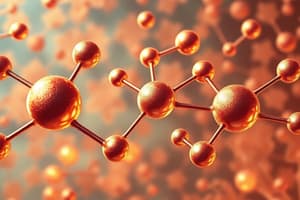Podcast
Questions and Answers
Which of the following molecules is non-polar despite having polar covalent bonds?
Which of the following molecules is non-polar despite having polar covalent bonds?
- NH3
- CCl4 (correct)
- PH3
- H2O
What determines the polarity of a molecule?
What determines the polarity of a molecule?
- The number of lone pairs on the central atom.
- The sum of the molecule's bond polarity vectors. (correct)
- The presence of only non-polar covalent bonds.
- The number of ionic bonds present.
In a bond dipole, which direction does the arrow point?
In a bond dipole, which direction does the arrow point?
- Away from the atom with a partial positive charge.
- Along the direction of any non-polar bond.
- Toward the more electronegative atom. (correct)
- Toward the less electronegative atom.
Which of the following best describes the relationship between molecular polarity and bond polarity?
Which of the following best describes the relationship between molecular polarity and bond polarity?
What is the partial charge symbol assigned to the less electronegative atom in a bond?
What is the partial charge symbol assigned to the less electronegative atom in a bond?
Which statement best describes the polarity of a molecule with a trigonal pyramidal shape?
Which statement best describes the polarity of a molecule with a trigonal pyramidal shape?
Concerning solubility, why does water not effectively remove oil stains?
Concerning solubility, why does water not effectively remove oil stains?
Given the molecule $CO_2$, what effect to the polarity of the molecule do the bond dipoles have?
Given the molecule $CO_2$, what effect to the polarity of the molecule do the bond dipoles have?
Flashcards
VSEPR and Molecular Polarity
VSEPR and Molecular Polarity
The shape of a molecule determines whether it is overall polar or non-polar, even if it contains polar bonds.
Molecular Polarity and Bond Vectors
Molecular Polarity and Bond Vectors
The overall polarity of a molecule is determined by the sum of the bond polarity vectors.
Bond Dipole
Bond Dipole
A bond dipole shows the direction of polarity within a bond, pointing from the less electronegative atom towards the more electronegative atom.
Electronegativity in Polarity
Electronegativity in Polarity
Signup and view all the flashcards
Polar Covalent Bonds and Polar Molecules
Polar Covalent Bonds and Polar Molecules
Signup and view all the flashcards
Shapes Leading to Polar Molecules
Shapes Leading to Polar Molecules
Signup and view all the flashcards
Non-polar Covalent Bonds and Polar Molecules
Non-polar Covalent Bonds and Polar Molecules
Signup and view all the flashcards
Polarity and Solubility
Polarity and Solubility
Signup and view all the flashcards
Study Notes
Molecular Polarity
- VSEPR shapes determine if a molecule is polar or non-polar.
- Water (H₂O) has polar covalent bonds and is a polar molecule.
- Carbon tetrachloride (CCl₄) has polar covalent bonds but is a non-polar molecule.
- Molecular polarity does not apply to ionic bonds.
Determining Molecular Polarity
- Molecular polarity results from the sum of bond polarity vectors.
- Electronegativity differences create partial charges (δ+ and δ−).
- δ+ indicates less electronegative, and δ− indicates more electronegative.
- Bond dipoles show the direction of polarity, pointing towards the more electronegative atom.
Polarity Determination Examples
- C–Cl: Polarity direction: C → Cl
- P–I: Polarity direction: P → I
- N–O: Polarity direction: N → O
Factors Affecting Polarity
- Polar covalent bonds may or may not result in a polar molecule.
- Non-polar covalent bonds may or may not result in a polar molecule.
- The shape of the molecule (VSEPR) is crucial in determining overall polarity.
- Consider bond dipoles as vectors.
Examples of Polar vs. Nonpolar Molecules
- CO₂ is a non-polar molecule, despite having polar bonds.
- CH₄ is a non-polar molecule.
- H₂O is a polar molecule.
Additional Considerations
- The X and Y vector components of bond dipoles sometimes cancel.
- Identifying if molecules like NH₃ and BF₃ are polar or non-polar.
- Determining if PH₃ is polar or non-polar.
- General rules: Trigonal pyramidal molecules (N, P) are polar; Trigonal planar molecules (B, O, and double bonded Carbon) are non-polar, while tetrahedral with same atoms is non-polar.
- CO₂ is an exception; while it has polar bonds, its linear shape results in a non-polar molecule.
External Factors
- Detergents clean clothes by disrupting hydrophobic interactions between dirt and fabric.
- Lipids and bile acids also have hydrophobic and hydrophilic interactions, disrupting lipid interactions.
Studying That Suits You
Use AI to generate personalized quizzes and flashcards to suit your learning preferences.




